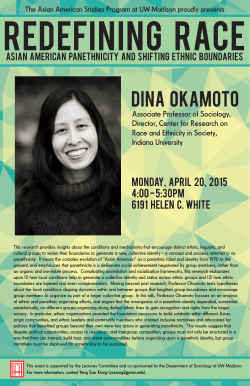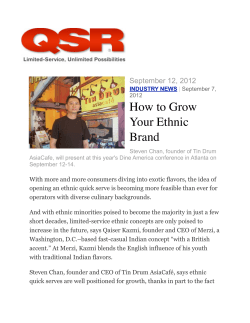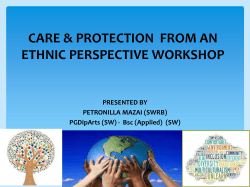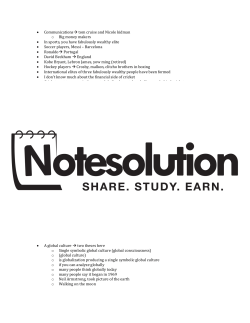
Sample Questions 1
Sample Questions 1 Intl 204, Koç University / Spring 2014 / Assoc. Prof. Murat Somer 1. Discuss the pro- and contra-arguments for the following statements: (1) Democracy requires active citizens who always know about and participate in politics (2) The best government policy in response to ethnic, racial and religious differences is accommodation as opposed to assimilation (3) Authoritarian regimes are the best for developing countries (4) socialism is superior to capitalism. 2. Aristotle defined politics in terms of its end goals. By contrast, many modern theories define politics based on its means, i.e. how people use power to determine “who gets what?” If power is central to politics, how can the underprivileged get a fair deal from the government? 3. (a) How does Max Weber define modern state? (b) Define different types of authority according to Weber. 4. Give some examples of oraganizations and identities that compete with (a) states (b) nations. Which features distinguish (c) modern state and (d) nations from competing organizations and identities? 5. Which features do (a) states and (b) nations share with competing institutions and identities? 6. Discuss how nationalism both undermines and complements democracy in different ways. 7. Why do environmental problems challenge the principle of national sovereignty in the world? Give examples of two other problems that similarly challenge this principle and explain why. 8. “Most authoritarian regimes have underdeveloped economies.” Does this statement refer to a correlation or causal relationship? Why? 9. What is level of analysis? How do levels of analyses focusing on structures and choices complement each other? Give an example of your own (not given in the lectures). Why is it impossible to study comparative politics without taking into account structures? 10. Explain the “most similar case” and “most different case” comparative methods. Give an example for each. 11. (a) Explain at least three ways we can measure how important class is in a society. (rather than poverty and inequality) (b) explain which factors would cause class divisions to deepen grow in a society (i.e. makes a society a class society). (c) Give some examples from your own life. (d) offer three practical policies that would reduce class divisions. 12. (a) Explain how the everyday usage of the term “state” differ from its usage by political scientists. (b) give an example where state as an organization conflicts with other organizations in society (c) give an example where state as an organization cooperates with other organizations in society. 13. Does globalization weaken states? Discuss by explaining releveant theories. 14. Explain modernization theory and Inglehart’s post-materialism theory and explain whether they conflict or agree with each other in predicting China’s future. 15. Where does political socialization take place in Turkey? Elsewhere? Give at least one example from a TIC country. 16. How is ideology similar to and different from (a) culture) and (b) religion? 17. Compare the political culture of the UK and Germany. Which historical events and characteristics were instrumental in shaping the political culture in each? 18. Why is identity so effective as a tool for political elites who are trying to mobilize members of the general public? 19. How are civic and ethnic nations different? Give an example for each from TIC. Also, give an example from TIC to explain how a national identity can be both ethnic and civic characteristics. 20. How does political science explain why people sometimes obey modern states and sometimes they do not? (why are some states more successful than others)? Explain by using the concepts of authority and legitimacy) 21. Nationalists want to mobilize a group of people (in a given territory and with a common identity) as a nation. To achieve this purpose, nationalists must tell two convincing stories, one justifying the identity boundary and the other justifying the territorial boundary. By giving examples from at least two TIC, explain how (a) ethnic nationalists and (b) civic nationalists do this. In other words, which stories do they tell to mobilize their nation? 22. Explain how primordialism, constructivism, and the radical middle poisition explain where identity comes from. 23. (a) Define complementary and cross-cutting identity cleavages. (b) Give an example for each from Iraq and Ukraine (c) from TIC countries 24. Imagine that you are given the following information. “On average, countries with rich natural resources are less industrialized and less democratic than those with few natural resources. (a) What is the dependent and independent variables in this empirical relationship? (b) By giving comparative examples, explain which theory can causally explain this relationship, and how some countries are able to become industrialized and democratic despite having rich natural resources. 25. “After taking power, Chinese communists sent researchers across the country to identify the existing ethnic groups. At the end, the government recognized (and thus helped sustain) only 55 groups out of more than 400 ethnic groups which applied for official recognition. Many groups were lumped together into the Han Chinese category. However, government efforts to homogenize the Han culturally and linguistically have had limited success. “ This narrative supports the following theory about ethnic identities: a. b. c. d. e. Ronald Suny’s “radical middle position” Donald Horowitz’ primordialism Russell Hardin’s instrumentalism Iris Young’s Constructivism None of the above 26. In general, Iranians are found to be more congenial to American social values and life style than many other Middle Eastern people such as Saudi Arabs. Yet, Iran also developed strong Islamist and nationalist ideologies with an anti-American orientation. Which theory would explain this better? a. b. c. d. e. Huntington’s “clash of civilizations” theory Benjamin Barber’s “Jihad vs. McWorld” Primordialist explanations of nationalism Constructivist explanations of nationalism None of the above 27. Social democrats want …. intervention in the economy and …. intervention in social values in favor of …….. values, while the conservatives want…. intervention in the economy and …. intervention in social values in favor of …….. values a. Low, moderate, egalitarian; low, high, traditional b. High, moderate, egalitarian; high, high, traditional c. High, high, egalitarian; low, high, Islamic d. High, moderate, egalitarian; low, high, traditional e. None of the above 28. Cleavage structure theory predicts that cross-cutting cleavages in a country …… group conflict while complementary (cumulative) cleavages ……… group conflict. What would be a country confirming this prediction? Give the name of the country and explain. 29. Fill in the blanks with the best available answer. National identities are ……… ethnicity because the former are …………… a. same as; territorial b. same as; territorial and include claims to self-government c. different from; territorial d. different from; territorial and include claims to self-government e. none of the above 30. What is the most distinctive definition of the modern nation? a) Subjective belief in common ancestry b) Belief in universal rights and freedoms c) Belief in territorial collective sovereignty d) Belief in monopoly on legitimate use of violence 31. According to our book, “civic nations” are common in ….. while “ethnic nations” are common in….. a) Eastern Europe; North and South America b) North and South America; Eastern Europe c) Asia; Africa d) Africa; Asia e) None of the above
© Copyright 2025





















